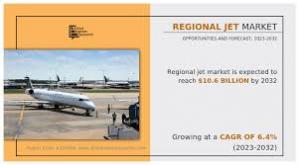Regional Jet Market Size Expected to Reach $10.6 Billion by 2032
The global regional jet market was valued at $5.7 billion in 2022, and is projected to reach $10.6 billion by 2032, growing at a CAGR of 6.4% from 2023 to 2032.
WILMINGTON, DE, UNITED STATES, August 25, 2025 /EINPresswire.com/ -- North America dominated the global regional jet market in 2022 driven by evolving travel patterns, technological advancements, and a strong demand for efficient and convenient air transportation. As the industry continues to flourish, regional jets are emerging as a vital component of the aviation sector, revolutionizing regional connectivity and enhancing the overall passenger experience.Get a Sample PDF Report to understand our report before you purchase: https://www.alliedmarketresearch.com/request-sample/A107604
With an increasing preference for shorter travel times and enhanced regional connectivity, more passengers are opting for regional jets for their travel needs. The efficiency and convenience offered by these aircraft make them an attractive choice for travelers seeking quick and seamless connections to their destinations.
In addition, Airlines are expanding their regional networks, adding more routes and destinations to cater to the growing demand. This expansion is facilitated by the deployment of regional jets, enabling airlines to serve smaller airports profitably and efficiently. Similarly, manufacturers in the regional jet market are investing in research and development activities to introduce innovative and cost-effective solutions. This competitive landscape is fostering the growth of the market, providing airlines with a wide range of options to choose from based on their specific requirements.
Furthermore, the continuous evolution of aviation technology drives the growth and efficiency of regional jets. Manufacturers are investing in research and development to introduce next-generation aircraft with improved fuel efficiency, reduced emissions, and enhanced passenger comfort. Technological innovations, such as lightweight materials, advanced avionics, and connectivity solutions, are reshaping the industry and fueling market growth. In addition, the global focus on sustainable practices has extended to the aviation industry.
Regional jets are being developed with a strong emphasis on environmental sustainability, including the use of alternative fuels, advanced aerodynamics, and eco-friendly cabin designs. These efforts align with the growing demand for eco-conscious travel options, positioning the regional jet market as a vital component of the sustainable aviation ecosystem.
Make a Direct Purchase: https://www.alliedmarketresearch.com/checkout-final/2dd74515cc7fdf4a19a2684fbce2d37a
Aircraft with seating capacities ranging from 25 to 130 passengers, regional jets serve as a bridge between major hubs and smaller regional airports. These jets offer enhanced flexibility, allowing airlines to efficiently serve niche markets and cater to the growing demand for shorter-haul flights. Regional jets enable improved connectivity and accessibility, opening up new opportunities for business and leisure travelers alike.
The regional jet market is segmented on the basis of platform, seating capacity, maximum take-off weight, and region. By platform, the market is segmented into commercial aircraft and military aircraft. Further, by seating capacity, the market is segmented into 15-80 seats and 80-125 seats. By maximum take-off weight, the market is segmented into 20,000 lbs. to 80,000 lbs. and 81,000 lbs. to 1,60,000 lbs. By region, the market is analyzed across North America, Europe, Asia-Pacific, and Latin America, Middle East & Africa (LAMEA) including country-level analysis for each region.
On the basis of platform, the global regional jet market is segmented into commercial aircraft and military aircraft. Commercial aircraft designed and optimized for regional air travel. These aircraft are smaller in size compared to their larger counterparts, such as wide-body and narrow-body jets and are specifically tailored to serve shorter routes and connect smaller airports within a specific region. There is a growing demand for commercial regional jets due to the need for efficient transportation solutions to connect regional and secondary airports.
As regional air travel continues to grow, especially in emerging economies and underserved regions, the demand for regional jets is expected to increase. The commercial aircraft market in the regional jet industry offers a range of aircraft options that can cater to these diverse needs. Airlines may prioritize fuel efficiency, passenger comfort, or flexibility in their fleet selection, depending on their operational objectives and market positioning.
To Ask About Report Availability or Customization, Click Here: https://www.alliedmarketresearch.com/purchase-enquiry/A107604
In addition, the increasing demand for larger regional jets with higher seating capacities. This has been driven by the need to transport larger volumes of passengers on regional routes, especially in densely populated areas or regions with high tourist activity. For instance, Embraer, a prominent manufacturer of regional jets, introduced the E190-E2 model. This aircraft has a seating capacity of up to 114 passengers, making it one of the larger regional jets available. The E190-E2 offers improved fuel efficiency and reduced operating costs compared to its predecessors, making it an attractive option for airlines operating on regional routes with higher passenger demand.
Key players operating in the global regional jet market are Airbus, Antonov Company, ATR, BAE Systems, Bombardier, Commercial Aircraft Corporation of China, Ltd., De Havilland, Embraer, MHI RI Aviation ULC, and Saab AB.
Key Findings Of The Study
By platform, the military aircraft segment is anticipated to exhibit significant growth in the near future.
By seating capacity, the 15-80 seats segment is anticipated to exhibit significant growth in the near future.
By maximum take-off weight, the 81,000 lbs. to 1,60,000 lbs. segment is anticipated to exhibit significant growth in the near future.
By region, LAMEA is anticipated to register the highest CAGR during the forecast period.
David Correa
Allied Market Research
+1 800-792-5285
email us here
Visit us on social media:
LinkedIn
Facebook
YouTube
X
Legal Disclaimer:
EIN Presswire provides this news content "as is" without warranty of any kind. We do not accept any responsibility or liability for the accuracy, content, images, videos, licenses, completeness, legality, or reliability of the information contained in this article. If you have any complaints or copyright issues related to this article, kindly contact the author above.

